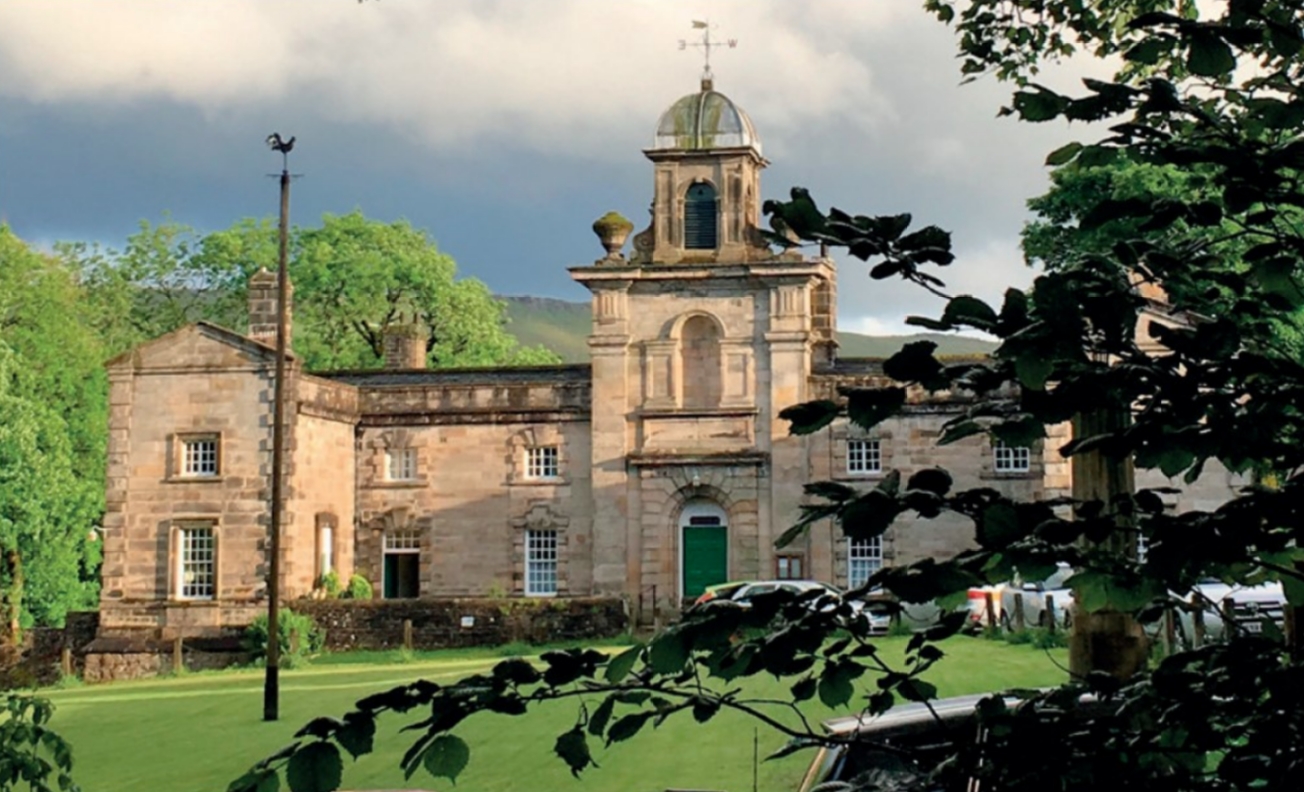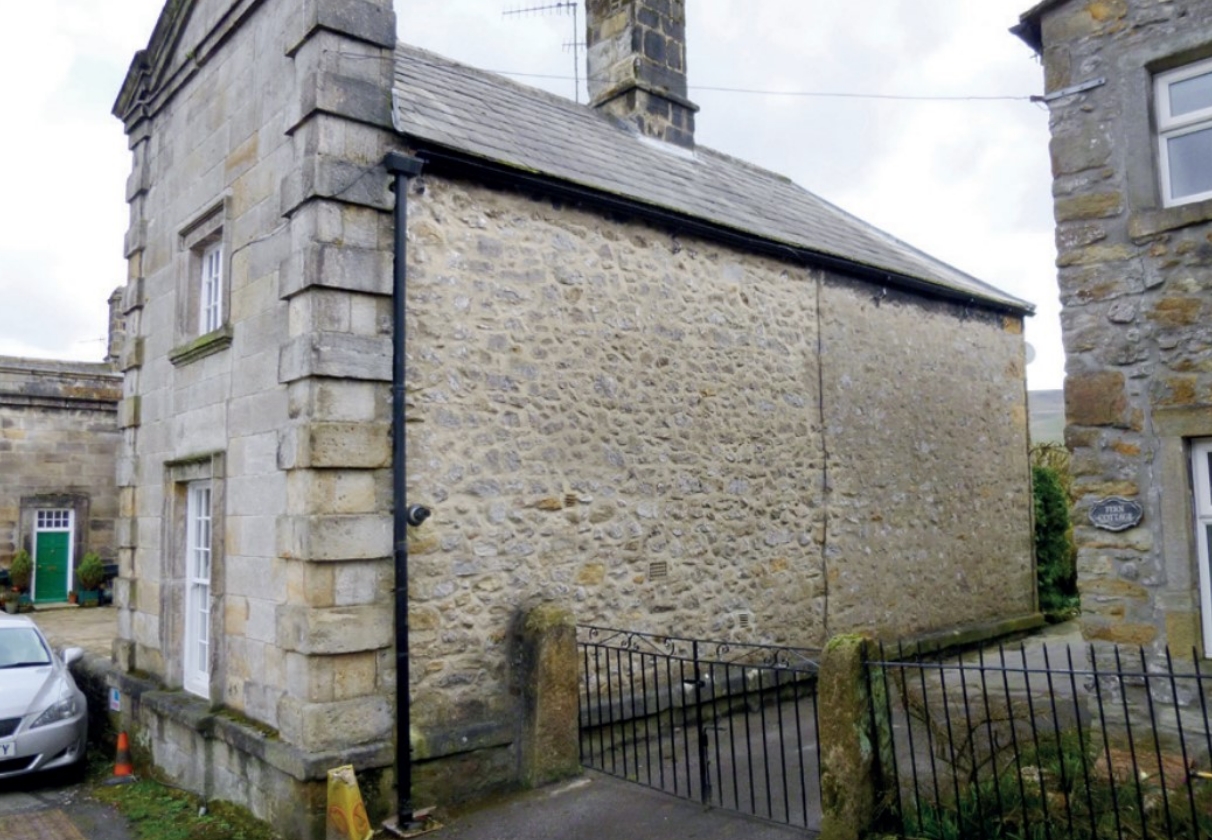Fountaine Hospital Almshouse
It is a mystery why, in the most modest of contexts, the Fountaine Hospital Almshouse was built, in the early to mid 1720s, of ambitious, sophisticated architecture in the baroque style.

|
| A June evening in Linton (Photo: Victoria Fattorini) |
Linton-in-Craven, in the Yorkshire Dales, is an unpretentious village. Until the mid-19th century, it was a parish with little poverty, and no more than 20 houses, stone-built, of vernacular style. Even then, with the creation of employment at a textile mill on the nearby River Wharfe, the village grew little. The mill closed in the 1950s; Linton has no shop or post office – just one inn on the green which draws in visitors for its food and drink.
In the early 18th century, the local residents were predominantly independent landowning farmers with small holdings and crofts. Hemp, and some wool, were the main crops for market. There were no large aristocratic landowners or patrons, no important estates or gentry houses. In the Linton of that period (and indeed to date) there are only two houses that might be described as of higher social status, although not of notable architecture – these belonging to families of the lower gentry.
Extraordinarily, in this modest context, was built, in the early to mid-1720s, an almshouse of ambitious, sophisticated architecture, of English baroque style. The Fountaine Hospital Almshouse, is unique among British almshouses. Almshouses are often humble, discreet edifices; they speak of the reduced circumstances of their residents, and the benefactor’s understated generosity. Not this one.
The central tower element is projected slightly forward and framed by two giant order pilasters (Doric, but without entasis), supporting an entablature (that is, the upper part of a classical building supported by columns or a colonnade, comprising the architrave, frieze and cornice), with triglyphs and a deeply projected cornice, capped by two large urns as finials.
Mystery and myths surrounded for long years – centuries even – the origins of the building. It was allowed to fall into disrepair in the 18th century – such that the Charity Commissioners intervened to reconstitute the Hospital’s Trust in the early 19th century. Fountaine family heirs, local to Linton, who had been the majority of trustees, were seen to be responsible for the abuse of the trust, and the executors of their agent, a Mr Holmes, were obliged to repay the substantial sum of £375 7s 11½d (about £75,000 in today’s money) to the new trustees. Unfortunately, most of this money was absorbed by the costs of the lawsuits required, and only £55 was returned to the charity.
It is most likely due to this mismanagement that the archives of the Hospital Trust hold almost no documents that date between the 1720s and the mid-1810s – most of these documents have gone missing or been destroyed; alternatively, proper records may never have been kept in the first place. There are no sketches, no drawings, no plans, no contracts, no building accounts, no letters – no primary source documents that might identify definitively the building’s architect, the decision-makers, or the process of design and construction.
It was known that the hospital was endowed by the will of a man from Linton, Richard Fountaine (1639–1722), who earned a fortune as a merchant in London. Little beyond that was known for certain about Fountaine the man, and many unfounded stories circulated in the 20th century – most due to the inventions of a novelist, Halliwell Sutcliffe, who himself came to live in Linton, and wove fictions about the legends of the Dales. The only instruction that Fountaine left in his will was that the building should be: ‘built in such a decent manner and proportion as the [trustees] shall seem (sic) meet and convenient.’
Fountaine’s will is lengthy, and prescriptive on many other matters – for instance, down to the colour of the garments that residents of the almshouses must wear, and how often they should go to church service. It is therefore significant that the rigorous Richard Fountaine leaves the decisions about the design of his monument to others.
Such is the impact of the building, and the swirl of mystery surrounding its origins, that it provokes many questions in the observer interested in its architectural history and context. Who made the key decisions about the style and design of the building? Who was the architect? Why was it built here in Linton? Are there other models or examples on which this building draws?
The architecture of the building itself throws up many issues. The original building, built between 1722 and (probably) 1726 was on the form of an E-plan, comprised of the fine north facade, with its side ranges and protruding wings, and the central chapel. In 1892, there was a major extension in the form of a south-east wing, to provide a further two units.
The main frontage is formed in regular coursed ashlar (finely cut stone), with pediment and cornice mouldings and dressings. The side (east and west) and rear (south) elevations are by contrast built of conventional early-18th-century Dales vernacular masonry, mostly random rubble walling with only very basic dressings or none at all.

|
| The north-west corner of the almshouse. |
One of the most striking features of the almshouse is the obvious contrast between the high status and quality of the north elevations, and the remainder of the 1720 fabric. The junctions of the two architectures is brutally clear at the two northern corners; the return of the single low string course back from the northeast corner in the 1720s build, while failing to continue this in the 1892 extension, only highlights the effect.
The north frontage and tower would have demanded an exceptionally high skill level of design, dimensioned drawing(s), and supervision, whereas all the other elements to the rear of this frontage could have been set out and executed by competent local builders.
Indeed, certain views even from the public green give the impression of a thin stage-set frontage not entirely happily integrated with the main body and functions of the almshouse. Such a sharp and visible contrast would be unusual if intended. An architect of ability who had designed the facade of the building would not have planned or accepted this, unless circumstances, finances or client had otherwise determined.
The two-storey wings are projected boldly forward, but their architecture lacks much of the confidence and boldness of the tower and its side ranges, having much simpler dressings than those adjacent to the central chapel tower. Their ashlar does not course with that of the flanking ranges, and painted internal corner lead downpipes do not fully conceal this change.
The first-floor windows of the wings are set in simply moulded stone surrounds, not Gibbs surrounds; and while these match those in the flanking ranges for pattern and size, there is an uncomfortably large area of plain ashlar above them beneath the pediment.
The doors of the inward return elevations are markedly different from the richly elaborated stonework of the Gibbs surround doors to the passages. The masonry above the door and under the returned parapet with cornice and blocking course is blind, again emphasising the contrast to the windows with rich surrounds of the flanking ranges adjacent.
The inconsistencies between the wings and the side ranges appear to be part of the original build and thus intended, rather than later 18th century additions, but might be a result of cost-saving measures needed during construction, again suggesting changes of style, design / designer, build date or funding crisis. The contrast between the architecture and construction of north frontage and the remainder of the 1720 fabric is also highly suggestive of a change of both designer and builder.
In fact, recent research reveals that, in lawsuits following the death of Fountaine, the Fountaine family heirs had challenged the actions of the executors, their use of the deceased’s assets, and the money spent on the almshouse, whose construction had already begun in 1723. A key executor had died in 1724, coinciding with these legal and financial disputes. These events would be totally consistent with the evidence that the building itself provides of a removal of the original architect and team.
The research also reveals that Richard Fountaine made his money as a merchant of haberdashery, and as a moneylender; that he married into the eminent Jekyll family; and that he had connections to many of the powerful persons of the City of London of his time. For many years, he lived close to, and worshipped at, the church of St Lawrence Jewry, near the Guildhall – a church rebuilt by Christopher Wren after the Great Fire of 1666. Although he did not prescribe baroque style for his commemorative almshouse, was its baroque architecture his favoured taste? Did those who commissioned the almshouse in his memory know that this was the style that he would have chosen for his imposing memorial?
The almshouse has been variously attributed to architects John Vanbrugh, Nicholas Hawksmoor, William Wakefield and William Etty. No definitive proof of the designer could be found in the documents, but the most likely candidate is William Etty, designer of Holy Trinity Church, Leeds, the Moot Hall, Leeds (demolished) and the Mansion House, York (attributed).
For more information see: Researching the history of Fountaine Hospital Almshouse.
References
- Michael Devenish and Jane Houlton (2018) The Fountaine Hospital Almshouse, Linton-in- Craven: an architectural history. Unpublished study for the FHA Trust. Copy available at the British Library, and at the RIBA Library.
- Jane Houlton (2018) An Almshouse for Linton: Richard Fountaine’s Legacy, Devenish Press. Available online from CL Hawley Books, http://www.clhawley.co.uk/richard-fountaines-legacy.
This article originally appeared as ‘An extraordinary baroque miniature’ in IHBC's Context 157 (Page 38), published in November 2018. It was written by Jane Houlton, a retired business and economic development consultant, who worked with her late husband, Michael Devenish, 1949–2016, director of CoDA Developments, on a research study into the architectural history of the Fountaine Hospital Almshouse. She completed the study for the FHA trustees after his death.
--Institute of Historic Building Conservation
Related articles on Designing Buildings Wiki
IHBC NewsBlog
Old Sarum fire in listed (& disputed) WW1 Hangar - Wiltshire Council has sought legal advice after fire engulfed a listed First World War hangar that was embroiled in a lengthy planning dispute.
UK Antarctic Heritage Trust launches ‘Virtual Visit’ website area
The Trust calls on people to 'Immerse yourself in our heritage – Making Antarctica Accessible'
Southend Council pledge to force Kursaal owners to maintain building
The Council has pledged to use ‘every tool in the toolbox’ if urgent repairs are not carried out.
HE’s Research Magazine publishes a major study of the heritage of England’s suburbs
The article traces the long evolution of an internal programme to research 200 years of suburban growth
IHBC Context 183 Wellbeing and Heritage published
The issue explores issues at the intersection of heritage and wellbeing.
SAVE celebrates 50 years of campaigning 1975-2025
SAVE Britain’s Heritage has announced events across the country to celebrate bringing new life to remarkable buildings.
IHBC Annual School 2025 - Shrewsbury 12-14 June
Themed Heritage in Context – Value: Plan: Change, join in-person or online.
200th Anniversary Celebration of the Modern Railway Planned
The Stockton & Darlington Railway opened on September 27, 1825.
Competence Framework Launched for Sustainability in the Built Environment
The Construction Industry Council (CIC) and the Edge have jointly published the framework.
Historic England Launches Wellbeing Strategy for Heritage
Whether through visiting, volunteering, learning or creative practice, engaging with heritage can strengthen confidence, resilience, hope and social connections.














